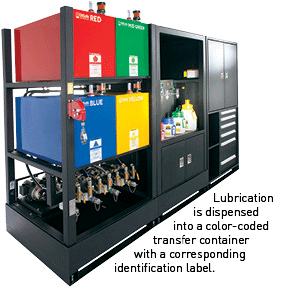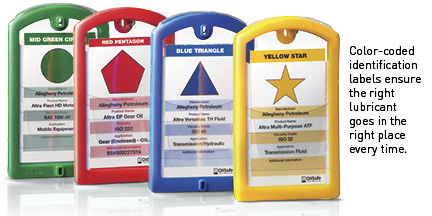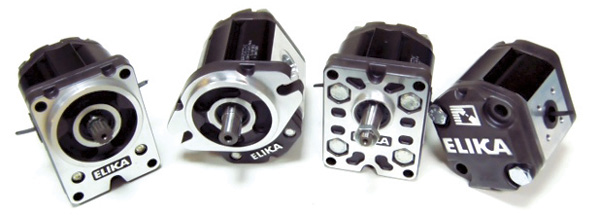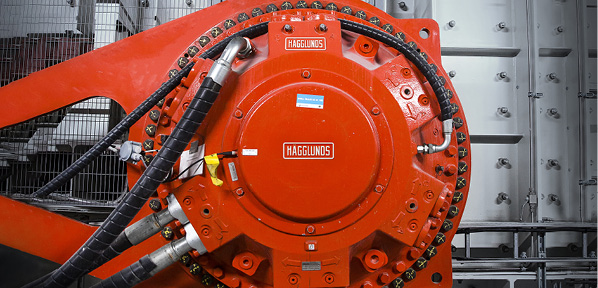Cracking the Code of Successful Maintenance Operations
 How Color Coding Enables Best-Practice Lubrication Management
How Color Coding Enables Best-Practice Lubrication Management
The lube room can be the most unorganized place on the plant floor. Dozens of different types of industrial lubricants may be stored in rows of plain containers that all look the same at a glance. Trying to make sense of it all can feel like detective work. Which container is for which lubricant? And which one goes in which machine? You have to either read ridiculously small type, decipher bad handwriting, or – even worse – guess.
Lubrication management should never be a guessing game. If lubricant ends up in the wrong fill point, it puts your machine life and your productivity at risk. That’s why many progressive businesses have adopted a system of color coding to keep their lubricants organized. It’s the best way to keep the lube room neat and make sure every lubricant goes in the right place at the right time — every time.
The Ease and Simplicity of Color-Coded Lubrication Management
The idea behind color-coded lubrication management is simple: Everything that comes into contact with lubricant during the maintenance process is marked with a color and symbol that correspond to a particular lubricant. This means all the drums, dispensers, transfer containers, and fill points in a color-coded system have colored tags or labels of some kind. Workers can easily see which items are to be used with which lubricant and where each lubricant should be applied. Following the path of any given lubricant from storage to application is as easy as connecting the dots — or colored symbols.
Color-coded lubrication management helps you do the following:
1. Prevent Lubricant Misapplication
Color-coded lubrication management systems are so intuitive that it’s nearly impossible for workers to put the wrong lubricant in a machine. Color coding helps every worker — even temps and seasonal hires — make the right decisions regarding lubrication application without having to scrutinize labels or understand the language printed on them.
In a recent independent survey of 228 manufacturers1, more than 75% of respondents said they believe human error is one of the most common causes of downtime. As logic follows, color-coded lubrication application helps workers apply lubricants correctly, and thus, it is one of the best ways to keep your machines up and running.
2. Eliminate Cross-Contamination
Color-coded lubrication systems also protect the quality of your lubricants throughout the maintenance process. These systems are designed so that each drum, dispenser, and transfer container touches only one type of lubricant — establishing a single point of contact. Segregating lubricants in this way prevents problems caused by cross-contamination, including clotting, base oil separation, thermal breakdown, thinning, thickening, and the formation of hard deposits — all of which can lead to machine damage and failure. Therefore, using color coding to keep your lubricants separated helps maximize machine uptime.
3. Foster Workplace Safety
Manufacturers who color code their lubrication process automatically have cleaner, safer facilities. The color-coded labels keep everything neat and organized, with fewer spills and drips, because workers simply don’t make the errors that cause hesitation or disruptions when filling containers and applying lubricants. And fewer spills mean fewer opportunities for workplace accidents, costly fines, and safety violations.
4. Safeguard Your Workflow
Color-coded lubrication systems don’t just keep machines working well; they keep your team working efficiently, effectively, and safely, too. Specifically:
- Lean Initiatives — Color coding simplifies your maintenance process, removing the confusion, guesswork, and messes that slow down workers. Plus, it helps you apply the lean poka-yoke mechanism of mistake proofing so your team can more easily maintain the quality of your entire operation.
- 5S Practices — Color-coded lubrication management helps you organize your workspace according to the 5S workplace organization methodology. The colors and symbols make it easy to sort your lubricants, set the order of your workflow, shine (or clean) the workplace, standardize the lubrication process, and sustain order in your facility. Applying these practices brings efficiency and effectiveness to your maintenance operations.
- The OSHA Right-to-Know Standard — Color-coded labels clearly communicate exactly what types of lubricants are used in your facility, as OSHA’s Right-to-Know standard requires. Plus, the labels allow room for universally understood safety symbols, when necessary, so your workers can easily see which lubricants require special care during handling.
Applying Lubrication Management Best Practices
Color coding doesn’t just make your lube room look nice. It also helps maintenance workers apply a broad range of best practices to ensure the accuracy, efficiency, and safety of the lubrication process.
Selecting the Best Color-Coded System
Not all color-coded lubrication management systems are created equal. When it’s time for your organization to begin researching your system options, be sure to heed the following advice:
1. Be Wary of Homegrown Systems.
It may be tempting to think you can just create your own system of color coding by using paint, colored tape, or markers. But no matter how neatly you apply the colors and draw the shapes, they won’t be perfectly consistent across all your containers. And inconsistencies lead to inefficiencies, simply because it will take your workers longer to verify that they’re using the right lubricant in the right place. This becomes especially true as the colors fade, chip, or peel over time. Plus, if using a homegrown system, you will quickly run out of colors and basic symbols, forcing you to incorporate additional labeling methods, such as using multiple basic symbols to identify lubricants, which can be extremely confusing for your workforce. In short, homegrown color-coding systems don’t eliminate errors in the lubrication process; they often introduce more of them.
2. Consider the Number of Lubricants You Use.
If your manufacturing operation requires only a small number of lubricants, a color-coding system with an equally small number of colors and symbols will suffice. But if your operation requires many different lubricants, a broad spectrum of colors and symbols isn’t necessarily the best option. The colors in broad-spectrum systems are often too similar to distinguish from one another, which defeats the purpose of color coding. The same is true for symbols that look too much alike. Be aware of this problem, and choose a system with enough color and shape combinations to meet your needs without confusing your workers.
3. Choose a System That Will Stand the Test of Time.
More than likely, you’ll want to invest in a color-coded lubrication management system that will last for many years. For this very reason, you should select a system with fade-resistant labels so the colors your workers rely on don’t change over time. Likewise, the ideal system should incorporate durable, industrial-grade labels that won’t peel or fall off with use. And the system you choose should be one that grows with you, allowing you to add more labels as you introduce new equipment with new lubrication requirements.
An Easy Way to Boost Your Bottom Line
Implementing a color-coded lubrication management system is a small, immediate change with big, lasting impact. More than just aesthetically pleasing, it saves your company money. Eliminating errors and cross-contamination during the lubrication process helps keep your machines up and running so your facility can stay productive. Plus, color-coded lubrication management ensures you waste less lubricant due to spills and mix-ups — and your team wastes less time trying to figure out which lubricant goes where. And finally, it helps you avoid OSHA fines. Altogether, color coding can have significant impact on your bottom line — all for little effort. The system is so intuitive, you can set it up and get started today with very little training.









I would like to know about the color coding of lubricants. We are using 10 types of lubricants and want to use color codings for the same. Kindly advise us. If you are providing any service for lubricants management we can avail the services